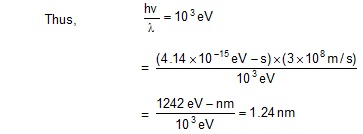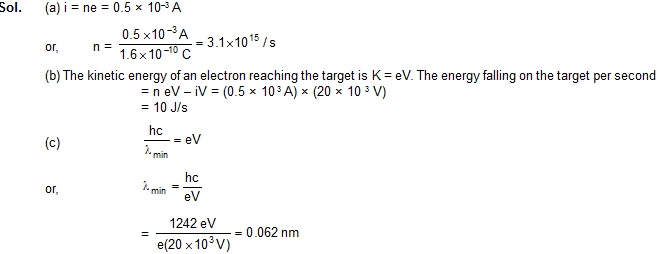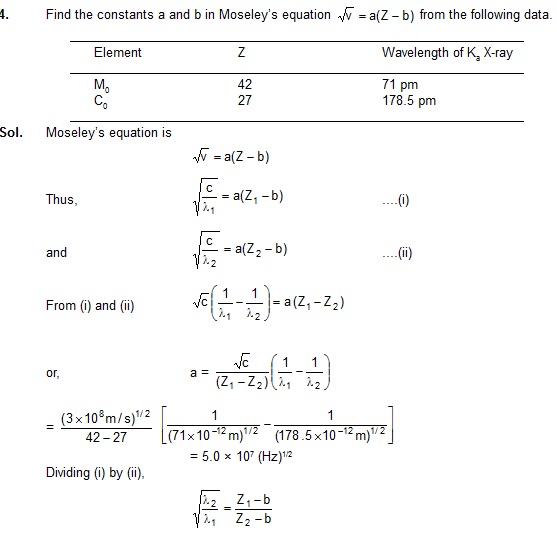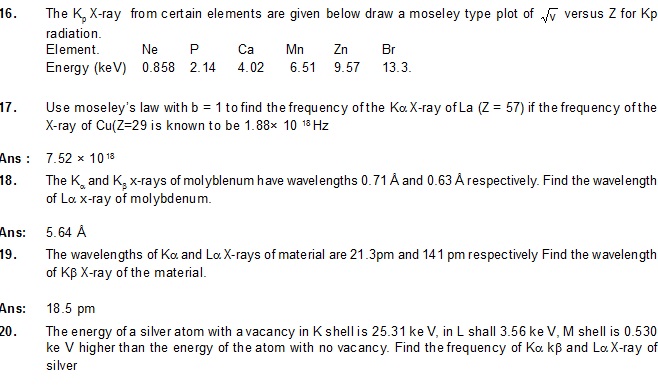Solved Examples
Questions for Short answer
1. When a Coolidge tube is operated for some time it becomes hot. Where does the heat from ?
2. In a Coolidge tube, electrons strike the target and stop inside it. Does the target get more and more negatively charged as time passes ?
3. Can X-rays be used for photoelectric effect ?
4. Can X-rays be polarized ?
5. X-rays and visible light travel at the same speed in vacuum. Do they travel at the same speed in glass ?
6. Characteristic X-rays may be used to identify the element from which they are coming. Can continuous X-rays be used for this purpose ?
![]()
9. Can a hydrogen atom emit characteristic X-ray ?
10. Whh is exposure to X-ray injurious to health but exposure to visible light is not, when both are electromagnetic waves ?
Objective - I
1. X-ray beam can be deflected
(A) by an electric field +
(B*) by a magnetic field
(C) by an electric field as well as by a magnetic field
(D) neither by an electric field nor by a magnetic field
2. Consider a photon of continuous X-ray coming from a Coolidge tube. Its energy comes from
(A*) the kinetic energy of the strilking electron
(B) the kinetic energy of the free electrons of the traged
(C) the kinetic energy of the ions of the traget
(D) an atomic transition in the target
3. The energy of a photon of characteristic X-ray from a Coolidge tube comes from
(A) the kinetic energy of the strilking electron
(B) the kinetic energy of the free electron of the target
(C) the kinetic energy of the ions of the target
(D*) an atomic transition in the target
4. If the potential difference applied to the tube is doubled and the separation between the filament and
the targer is also doubled, the cutoff wavelength
(A) will remain unchanged (B) will be doubled
(C) will be halved (D) will become four the original
5. If the current in the circuit for heating the filament is increased, the cutoff wavelength
(A) will increase (B) will decrease (C*) will remain unchanged (D) will change
![]()
(A*) both a and b are independent of the material
(B) a is independent but b depends on the material
(C) b is independent but a depends on the material
(D) both a and b depend on the material
7. Frequencies of KAlpha X-rays of deifferent materials are measured. Which one of the graphs in fig.
may represent the relation between the frequency n and the atomic number Z.
(D*)
8. The X-ray beam coming from an X-ray tube
(A) is monochromic
(B) has all wavelengths smaller than a certain maxiumu wavelength
(C*) has all wavelength greater than a certain minimum wavelength
(D) has all wavelength lying between a minimum and a maximum wavelength
9. One of the following wavelength is absent and the rest are presnet in the X-rays coming
from a Cooling tube, Which one is the absent wavelength ?
(A*) 25 pm (B) 50 pm (C) 75 pm (D) 100 pm
10. Fig,. shows the intensity-wavelength relations of X-rays coming from two different Cooling tubes.
The solid curve represents the relation for the tube A in which the potential difference between the target
and the filament is VA and the atomic number of the target material is ZA. These quantities are VB and ZB for the other tube. Then,
(A) VA > VB, ZA > ZB (B*) VA > VB, ZA < ZB
(C) VA < VB, ZA > ZB (D) VA < VB, ZA < ZB
11. 50% of the X-rays coming from a Coolidge tube is able to pass through a 0.1 mm thick aluminum foil.
If the potential difference between the target and th filament is increased, the fraction of the X-ray passing
through the same foil will be
(A) 0% (B) < 50% (C) 50% (D*) > 50%
12. 50% of the X-rays coming from a Coolidge tube is able to pass through a 0.1 mm tick aluminum foil.
The potential difference between the target and the filament is increased. The thickness of aluminimum foil,
which will allow 50% of the X-ray to pass through, will be
(A) zero (B) < 0.1 mm (C) 0.1 mm (D*) 0.1 mm
13. X-rays from a Coolidge tube is incident on a thin aluminium foil. The intensity of the X-ray transmitted
by the foil is found to be Io. The heating current is increased so as to increase the temperature of the filament.
The intensity of the X-ray transmitted by the foil will be -
(A) zero (B) < Io (C) Io (D*) > Io
14. Visible light passing through a circular hole forms a diffraction disc of radius 0.1 mm on a screen.
If X-rays is passed through the same set-up, the radius of the diffraction disc will be -
(A) zero (B*) < 0.1 mm (C) 0.1 mm (D) > 0.1 mm
Objective - II
1. For harder X-rays,
(A) the wavelength is higher (B) the intensity is higher
(C*) the frequency is higher (D*) the photon energy is higher
2. Cutoff wavelength of X-rays coming from a Coolidge tube depends on the
(A) target material (B*) accelerating voltage
(C) separation between the target and the filament (D) tepmerature of the filament
3. Mark the correct options.
(A) An atom with a vacancy has smaller energy than a neutral atom
(B*) K X-ray is emitted when a hole makes a jump from the K shell to some other shell
(C*) The wavelength of K X-ray is smaller than the wavelength of L X-ray of the same material
(D) The wavelength of Kalpha X-ray is smaller than the wavelength of Kbita X-ray of the same material
4. For a given material, the energy and wavelength of characteristic X-ray satisfy -

5. The potential difference applied to an X-ray tube is increased. As a result, in the emitted radiation,
(A) the intensity increases (B) the minimum wavelength increases
(C*) the intensity remains unchanged (D*) the minimum wavelength decreases
6. When an electron strikes the target in Coolidge tube, its entire kinetic energy
(A) is conberted into a photon (B*) may be converted into a photon
(C) is converted into heat (D*) may be converted into heat
7. X-ray incident on a material
(A*) exerts a force on it (B*) transfers energy to it
(C*) transfers momentum to it (D*) transfers impluse to it
8. Consider a photon of continuous X-ray and a photon of characteristic X-rays of the same
wavelength. Which of the following is/are different for the two photons ?
(A) frequency (B) energy (C) penetrating power (D*) method of creation
Worked Out Examples
1. Find the maximum frequency of the X-rays emitted by an X-ray tube operating at 30- kV.
. 
2. An X-ray tube operate at 20 kV. A particular electron loses 5% of its kinetic energy of to emit an
X-ray photon at the first collision. Find the wavelength corresponding to this photon.
Sol. Kinetic energy acquired by the by the electron
K = eV = 20×103 eV.
The energy og the photon
= 0.50×20=103 eV =103 eV.

3. An X-ray tube is operated at 20 kV and the current through the tube is 0.5 mA. Find (a) the number
of electrons hitting this target per second, (b) the energy falling on the target per second as the kinetic
energy of the electrons and (c) the cut off wavelength of the X-rays emitted.

4. Find the constants a and b in Moseley’s equation from the following data.


Exercise
1. Find the energy the frequency and the momentum of an x-ray photon of wavelength 0.10 nm.
Ans: 12.4 ke V, 3 × 10 18 Hz 6.62 × 10 – 24 kg m/s
![]()
Ans:. Find the cutoff wavelength for the continuous X-rays coming from an X -rays tube operating at 30 kV
3. Find the cutoff wavelength for the continuous X-rays coming from an X-ray tube operating at 30 kV.
Ans. 41.4 pm
4. What potential difference should be applied across an X-ray tube to get X-ray of wavelength not
less than 0.10 nm? What is the maximum energy of a photon of this X-ray in joule?
Ans: 12.4 kV, 2.0 × 10 – 15
5. The X-ray coming from a collide tube has a cutoff wavelength of 70 pm Find the kinetic energy of the electrons hitting the target
Ans: 15.5 ke V
6. If the operating potential in an X -ray tube is increased by 1% by what percentage does the cutoff wavelength decrease?
Ans: approximately
7. The distance between the cathode (filament ) and the target in an x-ray tube is 1.5 m If the curoff wavelength is 30 pm
, find the electric field between the cathode and the target
Ans: 27.7 kV/m
8. The short wavelength limit shifts by 26 pm when the operating voltage in an X-ray tube in increased to 1.5 times the original value .
What was the original value of the operating voltage ?
Ans: 15.9 kV
9. The electron beam in a colour TV is accelerated through 32 kv and then strikes the screen.
What is the wavelength of the most energetic X-ray photon ?
Ans: 38.8 pm
10. When 40 kv is applied across an X-ray tube X-ray tube X-ray is obtained with a maximum frequency
of 9.7 × 1018 Hz Calculate the value of planck constant from these data.
Ans : 4.12 × 10 – 15 eV – s
11. An X-ray tube operates at 40 kv suppose the electrons converts 70% of its energy into a photon at each collision.
Find the lowest three wavelengths emitted from the tube. Neglect the energy imparted to the atom with which the electron collides.
Ans: 44.3 pm , 493 pm
12. The wavelength of ka X-ray of tungsten is 21.3 pm It takes 11.3 ke to knock out a electrons from the
L shell of a tungsten atom. What should be the minimum accelerating voltage across an X-ray tube

Ans: 198 pm
15. A certain element emits ka X-ray of energy 3.69 ke V use the data from the previous problem to identify the element.
Ans: calcium

Ans: 5.25 × 10 18 Hz 5.98 × 10 18 Hz 7.32 × 10 17 Hz
21. Find the maximum potential difference which may be applied across an
X-ray tube with tungsten target without emitting any characteristic K or L X-ray
The energy levels of the tungsten atom with an electron knocked out are as follows .
Cell containing vacancy K L M
Energy in ke V 69.5 11.3 2.3
Ans: less than 11.3 kV
22. The electric current in a X-ray tube (from the target to the filament ) operating at 40K V is MA.
Assume that on an average 1% of the total kinetic energy of the electrons hitting the target ate converted into
X-rays. (a) What is the total power emitted as X-rays and (b) how much heat is produced in the target every second ?
Ans: (a) 4 W (b) 396 J
23. Heat at the rate of 200 W is produced in an X-ray tube operating at 20 kV Find the current in the circuit
Assume that only a small fraction of the kinetic energy of electrons is converted into X-rays.
Ans: 10 mA
24. Continues X-ray are made to strike a tissue paper soaked with polluted water. The incoming X-ray
excite the atoms of the sample by knocking out the electrons from the inner shells. Characteristic
X-ray are analysed and the intensity is plotted against the wavelength (figure 44 E1) Assuming that
only K intensities are detected list the elements present in the sample from the plot use mostly’s equation.
v = ( 25 ×1014 Hz ) (Z – 1)2
Ans : Zr , Zn, Cu, Fe
25. A free atom of iron emits Ka x-ray of energy 6.4 ke V calculate the recoil kinetic energy of the atom mass
of an iron atom = 9.3 × 10 26 kg.
Ans: 3.9 × 10 – 4 eV
26. The stopping potential in a photoelectric experiment is linearly related to the inverse of the wavelength
(1/ ) of the light falling on the cathode The potential difference applied across an X-ray tube is linearly
related to the inverse of the cutoff wavelength (1/) of the X-ray emitted show that the slopes of the lines in
the two cases are equal and find its value.
Ans: he/e = 1.242 × 10 – 6 V – m
27. Suppose a monochromatic X-ray beam of wavelength 100 pm is sent through a young’s double slit and the
interference pattern is observed on a photographic plate separation between the slits so that the successive
maxima on the screen are separated by a distance of 0.1 mm? [M_Bank_Chp-44_Ex-_27]
Ans: 4 × 10 – 7 m